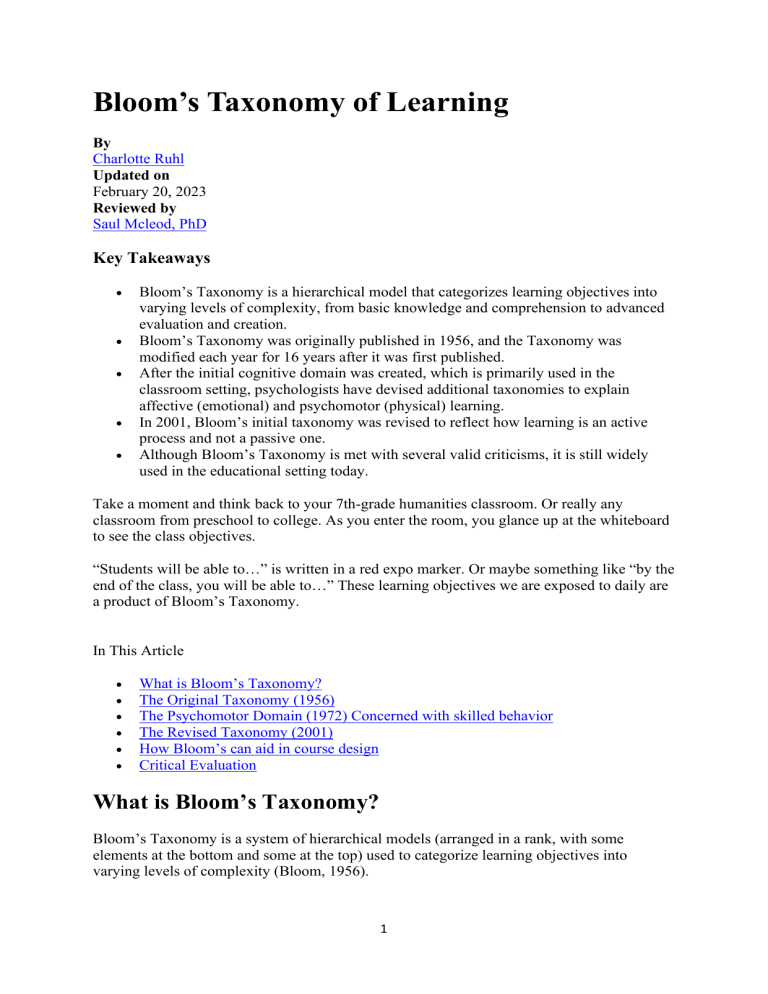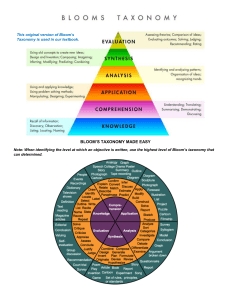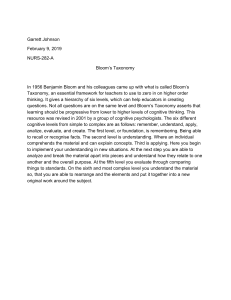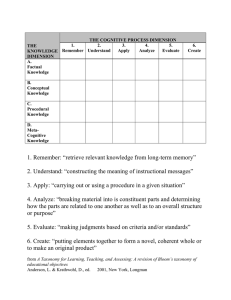Bloom's Taxonomy of Learning: Cognitive, Affective, Psychomotor Domains
advertisement

Bloom’s Taxonomy of Learning By Charlotte Ruhl Updated on February 20, 2023 Reviewed by Saul Mcleod, PhD Key Takeaways • • • • • Bloom’s Taxonomy is a hierarchical model that categorizes learning objectives into varying levels of complexity, from basic knowledge and comprehension to advanced evaluation and creation. Bloom’s Taxonomy was originally published in 1956, and the Taxonomy was modified each year for 16 years after it was first published. After the initial cognitive domain was created, which is primarily used in the classroom setting, psychologists have devised additional taxonomies to explain affective (emotional) and psychomotor (physical) learning. In 2001, Bloom’s initial taxonomy was revised to reflect how learning is an active process and not a passive one. Although Bloom’s Taxonomy is met with several valid criticisms, it is still widely used in the educational setting today. Take a moment and think back to your 7th-grade humanities classroom. Or really any classroom from preschool to college. As you enter the room, you glance up at the whiteboard to see the class objectives. “Students will be able to…” is written in a red expo marker. Or maybe something like “by the end of the class, you will be able to…” These learning objectives we are exposed to daily are a product of Bloom’s Taxonomy. In This Article • • • • • • What is Bloom’s Taxonomy? The Original Taxonomy (1956) The Psychomotor Domain (1972) Concerned with skilled behavior The Revised Taxonomy (2001) How Bloom’s can aid in course design Critical Evaluation What is Bloom’s Taxonomy? Bloom’s Taxonomy is a system of hierarchical models (arranged in a rank, with some elements at the bottom and some at the top) used to categorize learning objectives into varying levels of complexity (Bloom, 1956). 1 You might have heard the word “taxonomy” in biology class before, because it is most commonly used to denote the classification of living things from kingdom to species. In the same way, this taxonomy classifies organisms, Bloom’s Taxonomy classifies learning objectives for students, from recalling facts to producing new and original work. Bloom’s Taxonomy comprises three learning domains: cognitive, affective, and psychomotor. Within each domain, learning can take place at a number of levels ranging from simple to complex. Development of the Taxonomy Benjamin Bloom was an educational psychologist and the chair of the committee of educators at the University of Chicago. In the mid 1950s, Bloom worked in collaboration with Max Englehart, Edward Furst, Walter Hill, and David Krathwohl to devise a system that classified levels of cognitive functioning and provided a sense of structure for the various mental processes we experience (Armstrong, 2010). Through conducting a series of studies that focused on student achievement, the team was able to isolate certain factors both inside and outside the school environment that affect how children learn. One such factor was the lack of variation in teaching. In other words, teachers were not meeting each individual student’s needs and instead relied upon one universal curriculum. To address this, Bloom and his colleagues postulated that if teachers were to provide individualized educational plans, students would learn significantly better. This hypothesis inspired the development of Bloom’s Mastery Learning procedure in which teachers would organize specific skills and concepts into week-long units. 2 The completion of each unit would be followed by an assessment through which the student would reflect upon what they learned. The assessment would identify areas in which the student needs additional support, and they would then be given corrective activities to further sharpen their mastery of the concept (Bloom, 1971). This theory that students would be able to master subjects when teachers relied upon suitable learning conditions and clear learning objectives was guided by Bloom’s Taxonomy. The Original Taxonomy (1956) Bloom’s Taxonomy was originally published in 1956 in a paper titled Taxonomy of Educational Objectives (Bloom, 1956). The taxonomy provides different levels of learning objectives, divided by complexity. Only after a student masters one level of learning goals, through formative assessments, corrective activities, and other enrichment exercises, can they move onto the next level (Guskey, 2005). Cognitive Domain Concerned with thinking and intellect The original version of the taxonomy, the cognitive domain, is the first and most common hierarchy of learning objectives (Bloom, 1956). It focuses on the acquisition and application of knowledge and is widely used in the educational setting. This initial cognitive model relies on nouns, or more passive words, to illustrate the different educational benchmarks. 3 Because it is hierarchical, the higher levels of the pyramid are dependent on having achieved the skills of the lower levels. The individual tiers of the cognitive model from bottom to top, with examples included, are as follows: 1. Knowledge : recalling information or knowledge is the foundation of the pyramid and a precondition for all future levels → Example : Name three common types of meat. 2. Comprehension : making sense out of information → Example : Summarize the defining characteristics of steak, pork, and chicken. 3. Application : using knowledge in a new but similar form → Example : Does eating meat help improve longevity? 4 4. Analysis : taking knowledge apart and exploring relationships → Example : Compare and contrast the different ways of serving meat and compare health benefits. 5. Synthesis : using information to create something new → Example : Convert an “unhealthy” recipe for meat into a “healthy” recipe by replacing certain ingredients. Argue for the health benefits of using the ingredients you chose as opposed to the original ones. 6. Evaluation : critically examining relevant and available information to make judgments → Example : Which kinds of meat are best for making a healthy meal and why? Types of Knowledge Although knowledge might be the most intuitive block of the cognitive model pyramid, this dimension is actually broken down into four different types of knowledge: 1. Factual knowledge refers to knowledge of terminology and specific details. 2. Conceptual knowledge describes knowledge of categories, principles, theories, and structures. 3. Procedural knowledge encompasses all forms of knowledge related to specific skills, algorithms, techniques, and methods. 4. Metacognitive knowledge defines knowledge related to thinking — knowledge about cognitive tasks and self-knowledge (“Revised Bloom’s Taxonomy,” n.d.). However, this is not to say that this order reflects how concrete or abstract these forms of knowledge are (e.g., procedural knowledge is not always more abstract than conceptual knowledge). Nevertheless, it is important to outline these different forms of knowledge to show how it is more dynamic than one may think, and that there are multiple different types of knowledge that can be recalled before moving onto the comprehension phase. And while the original 1956 taxonomy focused solely on a cognitive model of learning that can be applied in the classroom, an affective model of learning was published in 1964 and a psychomotor model in the 1970s. The Affective Domain (1964) Concerned with feelings and emotion The affective model came as a second handbook (with the first being the cognitive model) and an extension of Bloom’s original work (Krathwol et al., 1964). 5 This domain focuses on the ways in which we handle all things related to emotions, such as feelings, values, appreciation, enthusiasms, motivations, and attitudes (Clark, 2015). From lowest to highest, with examples included, the five levels are: 1. Receiving : basic awareness → Example : Listening and remembering the names of your classmates when you meet them on the first day of school. 2. Responding : active participation and reacting to stimuli, with a focus on responding → Example : Participating in a class discussion. 3. Valuing : the value that is associated with a particular object or piece of information, ranging from basic acceptance to complex commitment; values are somehow related to prior knowledge and experience → 6 Example : Valuing diversity and being sensitive to other people’s backgrounds and beliefs. 4. Organizing : sorting values into priorities and creating a unique value system with an emphasis on comparing and relating previously identified values → Example : Accepting professional ethical standards. 5. Characterizing : building abstract knowledge based on knowledge acquired from the four previous tiers; value system is now in full effect and controls the way you behave → Example : Displaying a professional commitment to ethical standards in the workplace. The Psychomotor Domain (1972) Concerned with skilled behavior The third and final domain of Bloom’s Taxonomy is the psychomotor domain. The psychomotor model focuses on physical movement, coordination, and anything related to motor skills. Mastery of these specific skills is marked by speed, precision, and distance. These psychomotor skills range from simple tasks, such as washing a car, to more complex tasks, such as operating an intricate piece of technological equipment. As with the cognitive domain, the psychomotor model does not come without modifications. This model was first published by Robert Armstrong and colleagues in 1970 and included five levels: 1) imitation; 2) manipulation; 3) precision; 4) articulation; 5) naturalization. These tiers represent different degrees of performing a skill from exposure to mastery. Two years later, Anita Harrow (1972) proposed a revised version with six levels: 7 1) reflex movements; 2) fundamental movements; 3) perceptual abilities; 4) physical abilities; 5) skilled movements; 6) non-discursive communication. This model is concerned with developing physical fitness, dexterity, agility, and body control and focuses on varying degrees of coordination from reflexes to highly expressive movements. That same year, Elizabeth Simpson (1972) created a taxonomy that progressed from observation to invention. The seven tiers, along with examples, are listed below: 1. Perception : basic awareness → Example : Estimating where a ball will land after it’s thrown and guiding your movements to be in a position to catch it. 2. Set : readiness to act; the mental, physical, and emotional mindsets that make you act the way you do → Example : Desire to learn how to throw a perfect strike, recognizing one’s current inability to do so. 3. Guided Response : the beginning stage of mastering a physical skill. It requires trial and error → Example : Throwing a ball after observing a coach do so, while paying specific attention to the movements required. 4. Mechanism : the intermediate stage of mastering a skill. It involves converting learned responses into habitual reactions so that they can be performed with confidence and proficiency → Example : Successfully throwing a ball to the catcher. 5. Complex Overt Response : skillfully performing complex movements automatically and without hesitation → Example : Throwing a perfect strike to the catcher’s glove. 6. Adaptation : skills are so developed that they can be modified depending on certain requirements → Example : Throwing a perfect strike to the catcher even if a batter is standing at the plate. 7. Origination : the ability to create new movements depending on the situation or problem. These movements are derived from an already developed skill set of physical movements → Example : Taking the skill set needed to throw the perfect fastball and learning how to throw a curveball. The Revised Taxonomy (2001) In 2001, the original cognitive model was modified by educational psychologists David Krathwol (with whom Bloom worked on the initial taxonomy) and Lorin Anderson (who was a previous student of Bloom’s!) and published with the title A Taxonomy for Teaching, Learning, and Assessment . 8 This revised taxonomy emphasizes a more dynamic approach to education, as opposed to shoehorning educational objectives into fixed, unchanging spaces. To reflect this active model of learning, the revised version utilizes verbs to describe the active process of learning and does away with the nouns used in the original version (Armstrong, 2001). The figure below illustrates what words were changed as well as a slight adjustment to the hierarchy itself (evaluation and synthesis were swapped). Together, the cognitive, affective, and psychomotor models make up Bloom’s Taxonomy. How Bloom’s can aid in course design Thanks to Bloom’s Taxonomy, teachers across the nation have a tool to guide the development of assignments, assessments, and overall curricula. This model helps teachers identify the key learning objectives they want a student to achieve for each unit because it succinctly details the process of learning. The taxonomy explains that 1) before you can understand a concept, you need to remember it; 2) to apply a concept, you need to first understand it; 3) to evaluate a process, you need to first analyze it; 4) to create something new, you need to have completed a thorough evaluation (Shabatura, 2013). This hierarchy takes students through a process of synthesizing information that allows them to think critically. Students start with a piece of information and are motivated to ask questions and seek out answers. 9 Not only does Bloom’s Taxonomy help teachers understand the process of learning, but it also provides more concrete guidance on how to create effective learning objectives. Bloom’s Level Key Verbs (keywords) Example Learning Objective By the end of this lesson, the student will be design, formulate, build, invent, able to design an original homework Create create, compose, generate, problem dealing with the principle of derive, modify, develop. conservation of energy. choose, support, relate, By the end of this lesson, the student will be determine, defend, judge, grade, able to determine whether using conservation Evaluate compare, contrast, argue, justify, of energy or conservation of momentum support, convince, select, would be more appropriate for solving a evaluate. dynamics problem. classify, break down, categorize, By the end of this lesson, the student will be Analyze analyze, diagram, illustrate, able to differentiate between potential and criticize, simplify, associate. kinetic energy. calculate, predict, apply, solve, By the end of this lesson, the student will be illustrate, use, demonstrate, Apply able to calculate the kinetic energy of a determine, model, perform, projectile. present. describe, explain, paraphrase, By the end of this lesson, the student will be restate, give original examples Understand able to describe Newton’s three laws of of, summarize, contrast, motion to in her/his own words interpret, discuss. list, recite, outline, define, name, By the end of this lesson, the student will be Remember match, quote, recall, identify, able to recite Newton’s three laws of motion. label, recognize. The revised version reminds teachers that learning is an active process, stressing the importance of including measurable verbs in the objectives. And the clear structure of the taxonomy itself emphasizes the importance of keeping learning objectives clear and concise as opposed to vague and abstract (Shabatura, 2013). Bloom’s Taxonomy even applies at the broader course level. That is, in addition to being applied to specific classroom units, Bloom’s Taxonomy can be applied to an entire course to determine what the learning goals of that course should be. Specifically, lower-level introductory courses, that are typically geared towards freshmen, will target Bloom’s lower-order skills as students build foundational knowledge. However, that is not to say that this is the only level that is incorporated, but you might only move a couple of rungs up the ladder into the applying and analyzing stages. On the other hand, upper-level classes don’t place as much emphasis on remembering and understanding because students in these courses have already mastered this skill. 10 As a result, these courses focus instead on higher-order learning objectives such as evaluating and creating (Shabatura, 2013). In this way, professors can reflect upon what type of course they are teaching and refer to Bloom’s Taxonomy to determine what they want the overall learning objectives of the course to be. Having these clear and organized objectives allows teachers to plan and deliver appropriate instruction, design valid tasks and assessments, and ensure that such instruction and assessment actually aligns with the outlined objectives (Armstrong, 2010). Overall, Bloom’s Taxonomy helps teachers teach and helps students learn! Critical Evaluation Bloom’s Taxonomy accomplishes the seemingly daunting task of taking the important and complex topic of thinking and giving it a concrete structure. The taxonomy continues to provide teachers and educators with a framework for guiding the way they set learning goals for students and how they design their curriculum. And by having specific questions or general assignments that align with Bloom’s principles, students are encouraged to engage in higher order thinking. However, even though it is still used today, this taxonomy does not come without its flaws. As mentioned before, the initial 1956 taxonomy presented learning as a static concept. Although this was ultimately addressed by the 2001 revised version that included active verbs to emphasize the dynamic nature of learning, Bloom’s updated structure is still met with multiple criticisms. Many psychologists take issue with the pyramid nature of the taxonomy. The shape creates the false impression that these cognitive steps are discrete and must be performed independent of one another (Anderson & Krathwol, 2001). However, the vast majority of tasks require several cognitive skills to work in tandem with each other. In other words, a task will not be only an analysis or only a comprehension task. Rather, they occur simultaneously as opposed to sequentially. The structure also makes it seem like that some of these skills are more difficult and more important than others. However, when people adopt this mindset, it causes less emphasis to be placed on knowledge and comprehension, which are as, if not more, important that the processes towards the top of the pyramid. Additionally, author Doug Lemov (2017) argues that this contributes to a national trend that devalues the importance of knowledge. He goes even further to say that lower-income students who have less exposure to sources of information suffer from a knowledge gap in schools. A third problem with the taxonomy is that the sheer order of elements is inaccurate. When we learn, we don’t always start with remembering and then move on to comprehension and through to creating something new. Instead, we mostly learn by applying and creating. 11 For example, you don’t really know how to write an essay until you actually do it. And you might not know how to speak Spanish until you actually do it (Berger, 2020). The act of doing is where the learning lies, as opposed to moving through a regimented, linear process. Despite these several valid criticisms of Bloom’s Taxonomy, this model is still widely used today. References Anderson, L. W., Krathwohl, D. R. (2001). A taxonomy for learning, teaching, and assessing: A Revision of Bloom’s Taxonomy of Educational Objectives. New York: Longman. Armstrong, P. (2010). Bloom’s Taxonomy. Vanderbilt University Center for Teaching. Retrieved from https://cft.vanderbilt.edu/guides-sub-pages/blooms-taxonomy/ Armstrong, R. J. (1970). Developing and Writing Behavioral Objectives. Berger, R. (2020). Here’s what’s wrong with bloom’s taxonomy: A deeper learning perspective (opinion). Retrieved from https://www.edweek.org/education/opinion-hereswhats-wrong-with-blooms-taxonomy-a-deeper-learning-perspective/2018/03 Bloom, B. S. (1956). Taxonomy of educational objectives. Vol. 1: Cognitive domain. New York: McKay, 20, 24. Bloom, B. S. (1971). Mastery learning. In J. H. Block (Ed.), Mastery learning: Theory and practice (pp. 47–63). New York: Holt, Rinehart and Winston. Clark, D. (2015). Bloom’s taxonomy: The affective domain. Retrieved from http://www.nwlink.com/~donclark/hrd/Bloom/affective_domain.html Guskey, T. R. (2005). Formative Classroom Assessment and Benjamin S. Bloom: Theory, Research, and Implications. Online Submission. Harrow, A.J. (1972). A taxonomy of the psychomotor domain. New York: David McKay Co. Krathwohl, D. R. (2002). A revision of Bloom’s taxonomy: An overview. Theory into practice, 41 (4), 212-218. Krathwohl, D.R., Bloom, B.S., & Masia, B.B. (1964). Taxonomy of educational objectives: The classification of educational goals. Handbook II: Affective domain. New York: David McKay Co. Lemov, D. (2017). Bloom’s taxonomy-that pyramid is a problem. Retrieved from https://teachlikeachampion.com/blog/blooms-taxonomy-pyramid-problem/ Revised Bloom’s Taxonomy. (n.d.). Retrieved from https://www.celt.iastate.edu/teaching/effective-teaching-practices/revised-blooms-taxonomy/ 12 Shabatura, J. (2013). Using bloom’s taxonomy to write effective learning objectives. Retrieved from https://tips.uark.edu/using-blooms-taxonomy/ Simpson, E. J. (1972). The classification of educational objectives in the Psychomotor domain, Illinois University. Urbana. 13



